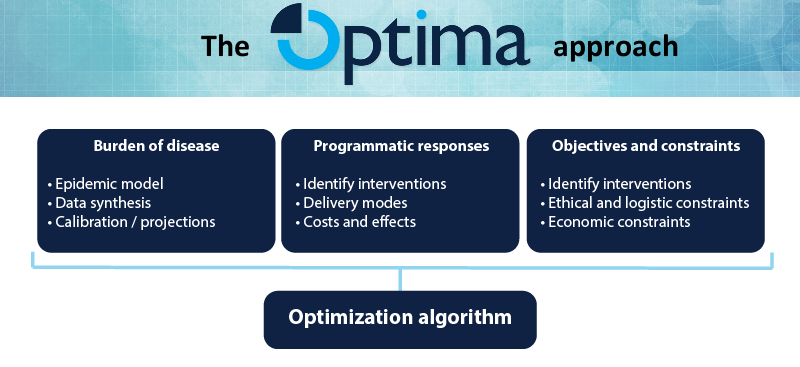I simply wish that in a matter which so closely concerns the wellbeing of the human race, no decision shall be made without all the knowledge which a little analysis and calculation can provide.Daniel Bernoulli, 1760
The Optima Consortium for Decision Science is group of academic partners working towards a common mission:
- We make software to support better decision making
- We are an active research group
- We work with countries to help them make better public health investment choices
We developed the “Optima approach”, which is a 4-step approach for use in informing public health investment choices. To make it easy for countries to use the Optima approach, we also developed a suite of software tools that encapsulate this approach.
The first step of the Optima approach involves assessing the burden of disease over time. This is done through data syntheses combined with epidemiological modeling. The Optima family of software tools each contain of a mathematical model of disease transmission and progression to make this step easy and intuitive for countries. The Optima structure is highly flexible and can accommodate public health programs and sub-populations specific to each country.
The next step in the Optima approach is to identify the interventions, including different service delivery modes and implementation options. The Optima tools are all integrated with an economic and financial analysis framework.
The third step of the Optima approach is to identify strategic objectives and national priority targets. Again, the Optima tools all provide an easy interface for specifying targets.
The previous 3 steps lead to the final and defining step in the Optima approach: using a formal mathematical optimization algorithm to calculate the optimal allocation of resources to different program areas, addressing the specific objectives of either: (a) reducing new infections, or disease-related deaths, or disability-adjusted life years, or a combination thereof; or (b) minimizing costs required to achieve specific targets.
The Optima tools also allow users to build scenarios linked to achieving specific targets. Different scenarios of coverage levels of core public health programs can be assumed, in which case the Optima tools can assess the impact of such investments. Scenarios can also be run for different impact targets to determine the cost of achieving specific reductions in incidence and deaths. Different scenarios are then compared and discussed to determine which scenario is most appropriate given the country context.
All software produced by the Optima Consortium is open-access, cloud-based software written in Python and JavaScript. Since it is used via a web interface, the only requirement for use is an internet connection. More information on the tools available for each disease area that we work in can be found under the menu headings.
The Optima approach and the software to implement it were conceptualized and developed by the Directors of the Optima Consortium for Decision Science in partnership with the World Bank. These concepts have been extended by the partners in the Consortium. Updates, revisions, and changes to the software are made by the core Optima team, supported by financial and intellectual inputs from the World Bank staff.


 © Optima Consortium for Decision Science, Burnet Institute, Melbourne, 2025
© Optima Consortium for Decision Science, Burnet Institute, Melbourne, 2025